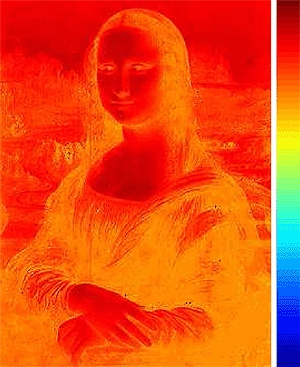The team’s creation, dubbed ‘Mini Lisa,’ is claimed to demonstrate a technique that could potentially be used to achieve nanomanufacturing of devices because the team was able to vary the surface concentration of molecules on such short-length scales.
The image was created with an atomic force microscope and ThermoChemical NanoLithography (TCNL). Going pixel by pixel, the Georgia Tech team positioned a heated cantilever at the substrate surface to create a series of confined nanoscale chemical reactions.
By varying only the heat at each location, Ph.D. candidate Keith Carroll reportedly controlled the number of new molecules that were created. The greater the heat, the greater the local concentration. More heat produced the lighter shades of grey. Less heat produced the darker shades in her dress and hair seen when the molecular canvas is visualized using fluorescent dye. Each pixel is spaced by 125 nanometres.
‘By tuning the temperature, our team manipulated chemical reactions to yield variations in the molecular concentrations on the nanoscale,’ said Jennifer Curtis, an associate professor in the School of Physics and the study’s lead author. ‘The spatial confinement of these reactions provides the precision required to generate complex chemical images like the Mini Lisa.’

According to the Georgia Institute of Technology, production of chemical concentration gradients and variations on the sub-micrometer scale are difficult to achieve with other techniques, despite a wide range of applications the process could allow.
The Georgia Tech TCNL research collaboration, which includes associate professor Elisa Riedo and Regents Professor Seth Marder, produced chemical gradients of amine groups, but expects that the process could be extended for use with other materials.
‘We envision TCNL will be capable of patterning gradients of other physical or chemical properties, such as conductivity of graphene,’ Curtis said in a statement. ‘This technique should enable a wide range of previously inaccessible experiments and applications in fields as diverse as nanoelectronics, optoelectronics and bioengineering.’
Another advantage, according to Curtis, is that atomic force microscopes are fairly common and the thermal control is relatively straightforward, making the approach accessible to both academic and industrial laboratories.
To facilitate their vision of nano-manufacturing devices with TCNL, the Georgia Tech team has recently integrated nanoarrays of five thermal cantilevers to accelerate the pace of production.
Because the technique provides high spatial resolutions at a speed faster than other existing methods, even with a single cantilever, Curtis is hopeful that TCNL will provide the option of nanoscale printing integrated with the fabrication of large quantities of surfaces or everyday materials whose dimensions are more than one billion times larger than the TCNL features themselves.
A paper detailing the work - Fabricating Nanoscale Chemical Gradients with ThermoChemical NanoLithography - is published online by the journal Langmuir.





Red Bull makes hydrogen fuel cell play with AVL
Formula 1 is an anachronistic anomaly where its only cutting edge is in engine development. The rules prohibit any real innovation and there would be...